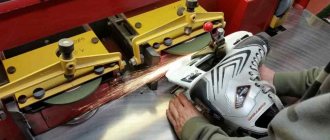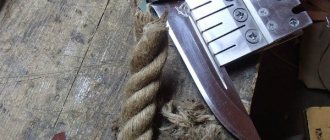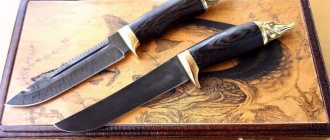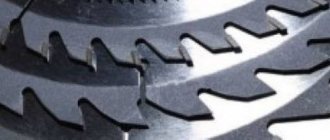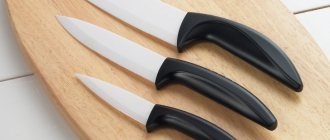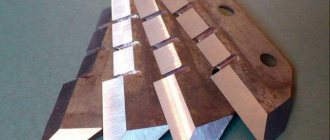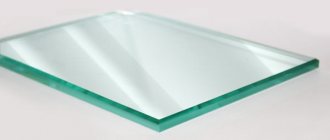A good quality ax can last you a lifetime and even longer if you care for it properly. One way to keep a tool in perfect condition is to sharpen it yourself; anyone can learn several ways to sharpen an ax. The great thing about sharpening yourself is that it doesn't require anything fancy, expensive or special.
A sharpened knife makes the job easier.
Ax sharpening options
There are different types of axes. There is a construction version, and there are carpentry and lumberjack models. A classic cleaver is used to prepare firewood. When cutting meat, meat axes are used.
When engaged in hunting and tourism - options of the same name. Any blade will wear out with constant use.
In production, each ax is sharpened before delivery, and regrinding is required when the cutting edge is seriously worn.
At home, the independent process of sharpening a tool can be done in two ways:
- Electrically driven equipment;
- Manually using an abrasive wheel and sanding paper.
For proper sharpening, the following must also be taken into account:
- Density, hardness and relative humidity of wood;
- Type of processing;
- Blade steel grade;
- The degree of hardening of the working edge.
In addition to the sharpening angle, it is important to consider the width of the chamfer of the cutting surface. To work with thin wood, a wider bevel is required. And, for example, when cutting thick trees, it should be smaller in order to reduce pressure on the blade.
How to sharpen it yourself?
Sharpening an ax is the process of forming a cutting edge. It occurs at the line of connection between two chamfers cut on both sides of the blade at the same angle. In order to ensure identical chamfers, uniform and symmetrical sharpening, you will first need to make a template, which is usually cut from a piece of tin using scissors. Before starting work, the template is applied to the blade, the amount of work is assessed and the lines delimiting the sharpening area are marked with a marker. This must be done on both sides of the blade.
In addition, you need to prepare a tool that can be used:
- Electric sharpener.
- Bulgarian.
- Sandpaper.
- Abrasive block.
It is most convenient to use an electric sharpener, but in the absence of anything you have to use what you have. An experienced master can achieve good results with any device; the main factor here is the availability of appropriate skills. Before starting the process, it is recommended to study special drawings.
Ax sharpening degree
The sharpening angle for various types of work is determined in accordance with the requirements of state standard 18578-89. This standard specifies all standard ax sizes and sharpening angles.
- For heavy work, on thick wood, a larger sharpening gradient is selected.
- The average angular value for sharpening cleavers is from 35 to 45 degrees.
- For cutting medium-sized trees, an angle of 30 degrees will be sufficient.
In carpentry practice, when processing wood of small thickness, blade sharpening is used at 20 degrees or less. These parameters apply similarly to all types of axes.
Design and types of product
The design of the ax has changed little over the millennia. The design of all varieties includes the following parts:
- steel blade with a spine;
- wooden or plastic handle - ax handle;
- metal or wooden wedges or other system for attaching the blade to the handle.
The blade is made from high-quality tool alloys with a carbon content of more than 0.7%.
According to their purpose, the following types of axes are distinguished:
- Plotnitsky (universal). The main purpose is carpentry work, but with such an ax it is possible to fell a small tree and chop firewood
- Cleaver. The purpose of a heavy tool with a long handle is to chop wood in large volumes. The shape of the blade prevents it from getting stuck in the log.
- Lumberjack. Optimized for logging: tree felling and delimbing. Weighs up to 2 kg.
- Tourist. Lightweight, small-sized hatchet for universal use. Purpose: to chop dead wood, spruce branches for overnight stays, tent stakes, etc.
- Multifunctional. The butt is made in the shape of a pickaxe, hammer head, or nail puller. Used by roofers and concrete workers, amateur builders for limited volumes of various works.
Carpenter's ax Tourist ax
There are also highly specialized varieties - for cutting meat carcasses, fire engines, used in historical reconstructions, etc.
Use of electrical equipment
It is considered the simplest option. It is enough to have electrical equipment and a 220 Volt outlet.
The sharpening angle is marked using the template, then using an abrasive wheel the chamfer of the cutting surface is brought to the desired value. Safety glasses and gloves will not interfere with the work.
Let's look at the procedure for sharpening an ax for carpentry:
- Using a marker, paint over the chamfer along the entire cutting surface of the axe. This is necessary to control the progress of sharpening the tool.
- Decide in advance on the sharpening angle depending on future work.
- Turn on the sharpening equipment and smoothly grind one surface of the ax. In this case, care should be taken to ensure that no nicks remain.
- Grind the second surface of the ax in the same way. Control the resulting angle using the template.
- Clean the surface with fine-grained sandpaper.
- Polish the surface with felt, after applying a special paste.
- Apply an anti-corrosion coating to the cutting surface.
If the surface of the ax gets very hot when sharpening, you should either dip it periodically in water or use oil. Any overheating of the metal negatively affects the hardness of the material.
Sharpening an ax by hand
If you don't have a power tool, you can sharpen the ax by hand. To do this, the following will be useful: a wide file, metal sandpaper, a sharpening stone, felt material, polishing paste, gloves and glasses.
The sharpening process is carried out in the following order:
- Use a wide file to process the cutting surface of the ax on both sides. Clean off all unnecessary irregularities.
- Remove burrs with metal sandpaper, making turning movements with the ax on one side and the other.
- Polish the sharpened surface and coat it with anti-corrosion material.
Sharpening by hand is difficult to do because you have to carefully work with the whetstone while holding the ax. Because of this, this option seems labor-intensive.
Mechanical cleaver
Nowadays mechanical cleavers equipped with a spring mechanism are produced. The drive is manual, but the spring takes on part of the load, which greatly simplifies the process of chopping wood.
On the Internet you can find photos of homemade cleavers that craftsmen make with their own hands. This is quite possible if you want not only to get things working without serious effort, but also to save money. The operation of the device is that a person swings, aiming at a log, it splits, and the mechanism returns to its original position.
If the question arises of how to make a cleaver yourself, then it is not so difficult. You will need a drawing and a general understanding of the principle of operation. You will need to assemble a structure like a tripod from an iron angle or channel. Elements - spacers - are attached to it for additional stability.
The level at which it would be optimal to place a moving beam or monorail is determined, to which the wood splitter itself, weighing approximately 35 kilograms, will be attached on one side. A spring mechanism is attached under them as a counterweight, providing movements such as swinging up and down. It would be useful to equip the mechanism with wheels to make it easier to move.
You can completely optimize the process by using such a splitting ax with an installed electric drive. The main element will be a cone, which, rotating, enters the log, and its physical shape contributes to the rupture of wood fibers and the log splits. This is done without the use of force.
In order to make such cleavers with your own hands, you will need to turn a conical part using a lathe. The device is activated by pressure passing through the liquid, the piston is activated, giving a force directed to the log, which is fed vertically. Using multiple blades will ensure that the wood is separated in one go.
Since a cleaver is a working tool, it doesn’t matter whether you purchased an expensive option or you made it yourself. The main thing is that it really simplifies work and saves time for more pleasant moments.
Common Mistakes
- Sharpening an ax using an angle grinder. When sharpening with an angle grinder, the surface of the ax becomes very hot. In addition, due to the high rotation speed, the sharpening surface does not turn out smooth.
- Overheating of the working surface. An excessive increase in the temperature of the metal leads to a change in its structure. It becomes coarse-grained and its impact strength decreases.
- Wear of sharpening tools. It is recommended to periodically change sharpening discs and abrasive stones.
In most cases, there is no point in completely demolishing the “native” factory sharpening. It is necessary to monitor the cutting surface, by which you can determine in advance whether the tool is dull or not.
With proper care, only a small sharpening of the edge of the ax will be enough. The current tool consists of high quality steel grades, without the need for constant regrinding.
There are rare moments when an ax hits nails or other metal parts. In this case, it is enough to use a regular abrasive stone.
Precautions during operation
Sharpening an ax is dangerous in many ways, and therefore requires compliance with safety precautions:
- Always wear hearing and eye protection.
- When using tools, make sure you know how to use them and read all safety instructions that come with the tool.
- Make sure you are not wearing loose clothing. Wear a long-sleeve shirt, pants and shoes.
- Wear gloves when filing an ax by hand.
- After sharpening, be careful when running your finger along the blade.
